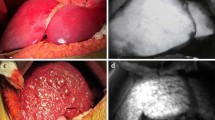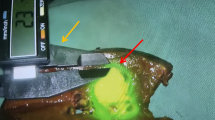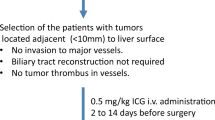Abstract
Background
Detecting small nodules that are grossly unidentifiable remains a major challenge in liver resection for cancer. Novel developments in navigation surgery, especially indocyanine green (ICG)-based fluorescence imaging, are making a clear breakthrough in addressing this issue. ICG is almost routinely administered during the preoperative stage in hepatobiliary surgery. However, its full potential has yet to be realized, partly because there are no precise guidelines regarding the optimal dose or timing of ICG injections before liver surgery. The main goal of this study was to design an algorithm for the management of ICG injections to achieve optimal liver staining results.
Methods
Twenty-seven consecutive, unselected patients undergoing liver resection for cancer were enrolled and underwent preoperative liver function assessment by the LiMON test. Extra ICG i.v. injections at different doses and timings were performed. In vivo intraoperative analysis of the stain detected by near-infrared fluorescence imaging of the liver and ex vivo analysis of each resected nodule was performed and compared to the pathological analysis.
Results
(i) The success rate of ICG injections in terms of liver staining was 92.6%; (ii) in the absence of or with 7 or more days from a previous ICG injection, the best dose to inject before the operation was 0.2 mg/kg, and the best timing was between 24 and 48 h before the scheduled surgery; and (iii) the ICG fluorescence patterns observed in the tumors were total fluorescence staining (41% of the cases), partial fluorescence staining (15%), rim fluorescence staining surrounding the tumor (30%), and no staining (15%).
Conclusions
This study is a building block for the characterization of liver nodules and the search for additional surface lesions undetected by preoperative radiological work-up—a crucial task for the successful treatment of liver cancer at an early stage using a safe, minimally invasive, and inexpensive technique.





Similar content being viewed by others
References
Boni L, David G, Mangano A, Fingerhut AL (2015) Clinical applications of indocyanine green (ICG) enhanced fluorescence in laparoscopic surgery. Surg Endosc 29:2046–2055
Ishizawa T, Bandai Y, Ijichi M, Kaneko J, Hasegawa K, Kokudo N (2010) Fluorescent cholangiography illuminating the biliary tree during laparoscopic cholecystectomy. Br J Surg 97:1369–1377
Ogata F, Narushima M, Mihara M, Azuma R, Morimoto Y, Koshima I (2007) Intraoperative lymphography using indocyanine green dye for near-infrared fluorescence labeling in lymphedema. Ann Plast Surg 59:180–184
Reinhart MB, Huntington CR, Blair LJ, Heniford BT, Augenstein VA (2016) Indocyanine green: historical context, current applications, and future considerations. Surg Innov 23:166–175
Kusano M, Kokudo N, Toi M, Kaibori M (eds) (2016) ICG fluorescence imaging and navigation surgery. Springer, New York
Zelken JA, Tufaro AP (2015) Current trends and emerging future of indocyanine green usage in surgery and oncology: an update. Ann Surg Oncol 22:S1271–S1283
Kusano M, Tajima Y, Yamazaki K, Miwa M (2008) Sentinel node mapping guided by indocyanine green fluorescence imaging: a new method for sentinel node navigation surgery in gastrointestinal cancer. Dig Surg 25:103–108
Ishizawa T, Fukushima N, Shibahara J, Masuda K, Tamura S, Aoki T, Hasegawa K, Beck Y, Fukayama M, Kokudo N (2009) Real-time identification of liver cancers by using indocyanine green fluorescent imaging. Cancer 115:2491–2504
Gotoh K, Yamada T, Ishikawa O, Takahashi HE, Yano M, Ohigashi H, Tomita Y, Miyamoto Y, Imaoka S (2009) A novel image-guided surgery of hepatocellular carcinoma by indocyanine green fluorescence imaging navigation. J Surg Oncol 100:75–79
Kokudo N, Ishizawa T (2012) Clinical application of fluorescence imaging of liver cancer using indocyanine green. Liver Cancer 1:15–21
Takahashi H, Zaidi N, Berber E (2016) An initial report on the intraoperative use of indocyanine green fluorescence imaging in the surgical management of liver tumors. J Surg Oncol 114:625–629
Lim C, Vibert E, Azoulaya D, Salloum C, Ishizawa T, Yoshioka R, Mise Y, Sakamoto Y, Aoki T, Sugawara Y, Hasegawa K, Kokudo N (2014) Indocyanine green fluorescence imaging in the surgical management of liver cancers: current facts and future implications. J Visc Surg 151:117–124
Ishizawa T, Saiura A, Kokudo N (2016) Clinical application of indocyanine green-fluorescence imaging during hepatectomy. HepatoBiliary Surg Nutr 5:322–328
Lau H, Man K, Fan S, Wong J (1997) Evaluation of preoperative hepatic function in patients with hepatocellular carcinoma undergoing hepatectomy. Br J Surg 84:1255
Kaibori M, Ishizaki M, Matsui K, Kwon AH (2011) Intraoperative Indocyanine green fluorescent imaging for prevention of bile leakage after hepatic resection. Surgery 150:91–98
Aoki T, Yasuda D, Shimizu Y, Kusano M (2008) Image-guided liver mapping using fluorescence navigation system with indocyanine green for anatomical hepatic resection. World J Surg 32:1763–1767
Ishizawa T, Zuker NB, Kokudo N, Gayet B (2012) Positive and negative staining of hepatic segments by use of fluorescent imaging techniques during laparoscopic hepatectomy. Arch Surg 147:393–394
Peloso A, Franchi E, Canepa MC, Barbieri L, Briani L, Ferrario J, Bianco C, Quaretti P, Brugnatelli S, Dionigi P, Maestri M (2013) Combined use of intraoperative ultrasound and indocyanine green fluorescence imaging to detect liver metastases from colorectal cancer. HPB 15:928–934
Abo T, Nanashima A, Tobinaga S, Hidaka S, Taura N, Takagi K, Arai J, Miyaaki H, Shibata H, Nagayasu T (2015) Usefulness of intraoperative diagnosis of hepatic tumors located at the liver surface and hepatic segmental visualization using indocyanine green-photodynamic eye imaging. Eur J Surg Oncol 41:257–264
Acknowledgements
This study was supported by the University Hospital of Brescia (Spedali Civili di Brescia), Italy, the University of Brescia, and RicerChiAmo onlus (http://www.ricerchiamobrescia.it). The equipment used in this study was made available by both Karl Storz and Stryker companies.
Author information
Authors and Affiliations
Contributions
GLB developed the original idea and methodology of the project and made substantial contributions to the manuscript. MSA wrote the first draft of the paper and incorporated the conceptual feedback sent by the coauthors. SM, SB, BM, PP, and EA collected intraoperative images and performed the literature search and review. NP, FG, and MB made scientific contributions to the project and critically revised the manuscript.
Corresponding author
Ethics declarations
Disclosures
GL Baiocchi was the scientific organizer of the international workshop “Intraoperative ICG Fluorescence Imaging in Hepatobiliary and Visceral Surgery: State of the Art and New Frontiers,” (Brescia, Italy, October 21, 2017) partly funded (travel expenses) by Karl Storz and Stryker companies though he has no direct conflict of interest with the content discussed in this manuscript. Drs. MS Alfano, S Molfino, S Benedicenti, B Molteni, P Porsio, E Arici, F Gheza, Profs. M Botticini, and N Portolani have no conflicts of interest or financial ties to disclose.
Rights and permissions
About this article
Cite this article
Alfano, M.S., Molfino, S., Benedicenti, S. et al. Intraoperative ICG-based imaging of liver neoplasms: a simple yet powerful tool. Preliminary results. Surg Endosc 33, 126–134 (2019). https://doi.org/10.1007/s00464-018-6282-1
Received:
Accepted:
Published:
Issue Date:
DOI: https://doi.org/10.1007/s00464-018-6282-1




